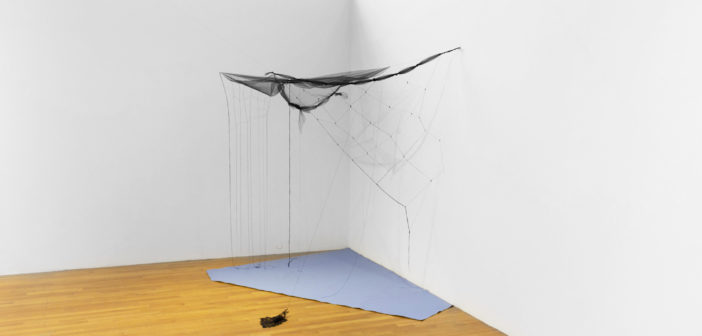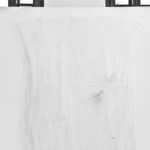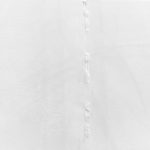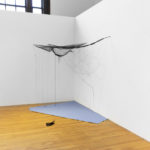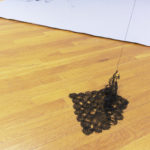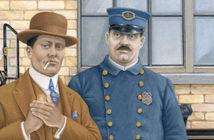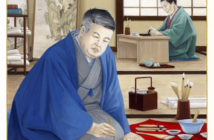I recently had the opportunity to engage in a wonderful conversation with Betty Jarvis, a recent Master’s graduate from the Art History program at Rutgers University. I find that conversations outside of the studio are just as important as your inner dialogue, if not more! After graduate school I spoke with visiting artists at the Vermont Studio Center and am really missing that dialogue, so I wanted to foster one myself.
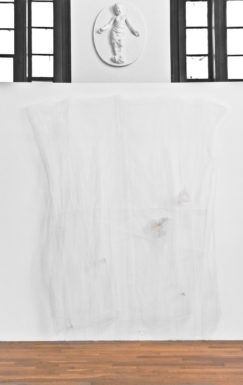
Diana Jean Puglisi, "Too Silver for a Seam," 2016, Courtesy of the artist.
My work was included in an exhibition called Accumulating Experience, curated by Betty, at the Newark Open Doors Arts Festival. The concept for the exhibition and the conversation I had with Betty began to make me think about the personal and the communal from a new perspective. My most recent work still has ties to our conversation. In talking with my peers and visiting artists at the VSC residency, I noticed that certain colors, shapes and forms begin to conjure associations with the body (or the female body more specifically) for almost everyone—even myself. Nude-color fabric, even if it isn’t nylon, begins to reference stockings. Light pastel colors bring people to the feminine quickly. I really want to know why these associations are shared amongst many, even if they are disassociated from their original context.
My conversation with Betty also made me realize how intertwined my personal life and work is. When I reflect, I begin to say “Oh maybe I did this because …. “, which tends to be something I experienced, whether it is a traumatic, transformative, or emotional memory.
The following is an excerpt from our dialogue:
Betty Jarvis: In an artist statement submitted to Newark Open Doors, you say, “I gravitate towards gendered materials worn during transformative events.” Some of the artists included in the exhibition in addition to yourself, such as William Norton and David French, are fueled to make artwork due to a singular trauma, while your work is almost literally created from layers of experiential events. I would love for you to expound on your statement. Where does the urge to utilize charged materials in your work come from?
Diana Jean Puglisi: I can’t really answer this question with one singular moment or why exactly I do it, although I think I am getting closer to it. A lot has to do with the death of my grandparents. I made this work at a time of mourning and loss. I was very close to my grandfather, so in approach the amber flits, the material on the floor is made from a cut piece of fabric from the back of my grandfather’s wool suit that he was buried in. The pattern for the lace comes from my grandmother’s hand-made lace. It is made into a digital file, and then cut at a high setting to make each piece look fragile. Morbid I know, but there was something about the process for me, burning the wool and smelling the scent of burning hair. The process was ritualistic and funerary. I built a tent, similar to funeral bunting. It became a shrine for them. It is placed into a corner because corners are both vulnerable and comforting places to be, it is poetic and metaphoric. In my review board our guest critic was Joyce Kozloff. She told me that my work makes her feel like someone is in the room that she does not know, a spirit, and that she can feel their presence. My interest in this comes from artists like Doris Salcedo and Rachel Whiteread. I used only tulle for the work that will be in Accumulating Experience because I feel like it haunts you at a young age, particularly and peculiarly as a female: baptism, ballet recital, communion, wedding, funerals.
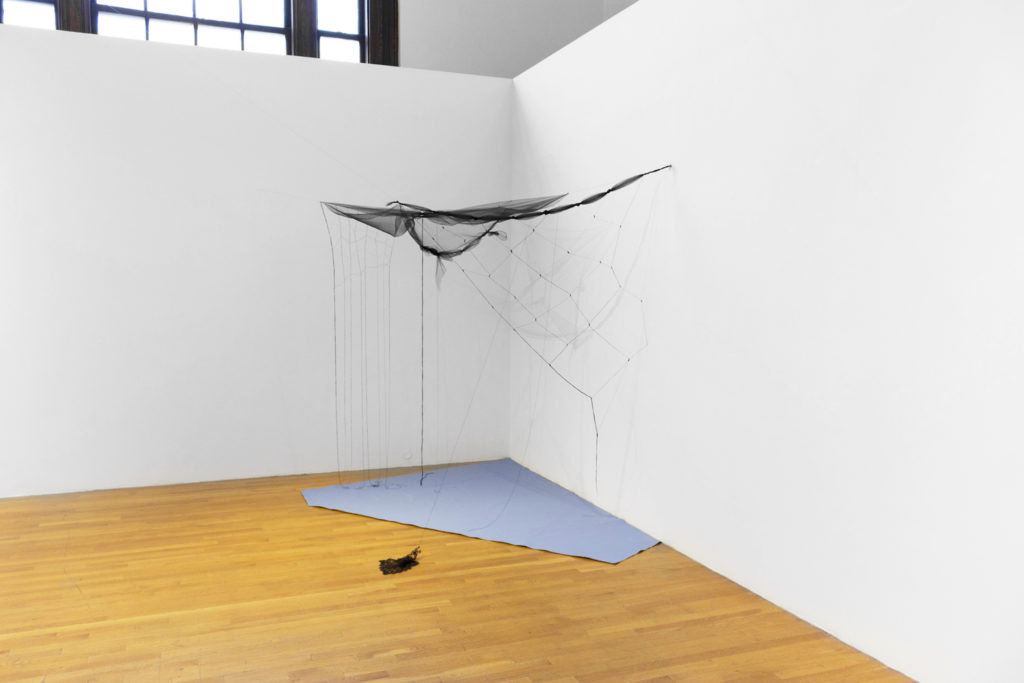
Diana Jean Puglisi, "approach the amber flits," 2016, Courtesy of the artist
BJ: What constitutes “experience” for you? How do you see it in, and emerging from, your work?
DJP: I think of experience as an emotional response that comes from something personal, and then through material specificity, personal history, and/or intuitiveness it begins to place itself into my work. The work in the exhibition came from a few direct experiences of loss. I watched my grandmother battle with Alzheimer’s disease for over ten years. I saw her physical body, and then realized that she died when her memories did, which is heartbreaking and fascinating. I also have deeper, direct experiences of loss from an outsider perspective of seeing someone react to loss right before their eyes, which I can’t really get too deeply into in order to respect a close friend of mine. This one experience I saw with death made me develop an anxiety disorder that still affects [me]. I am realizing my work [is rooted in]this more often than I thought. This body of work is about making presence through absence, about making something or really somebody feel like they are still here, or standing beside you, yet all there is is emptiness, a void.
BJ: Do you have any preconceived ideas about how viewers will interact with your work? What type of relationship do you hope to take place?
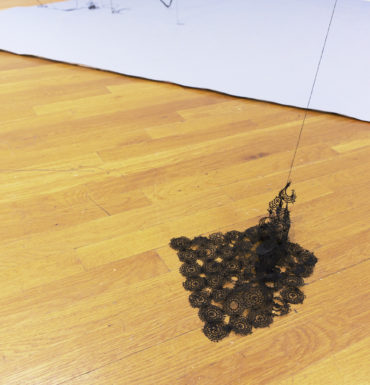
Diana Jean Puglisi, "approach the amber flits" (detail), 2016, Courtesy of the artist.
DJP: I don’t. I am very aware [of]how their bodies will navigate them, though. For example, approach the amber flits is in a corner and blocks access to two sides of the piece, conceptually, so you are blocked access to [half of]the piece. I really thought about this piece as looking into it, similar to how one views a casket. I know that my white works take time. They can easily be ignored because of [their]subtle qualities, but when given time you begin to see subtle variations in color, and exactly what it is you are looking at. The shadow seems more real than the tangible object. I hope my viewers have an intimate relationship with the piece, an emotional one, and the desire to get close.
BJ: I feel as though much of your work, such as the pieces Too Silver for a Seam and Approach the Amber Flits, included in the upcoming exhibition, has a fluidness and instability embedded in the softly draped materials. There is a sense of transition and an emphasis on process that brings to mind the idea of “anti-form”. Do you see your work in dialogue with any art historical figures, through their own artwork or writings?
DJP: Yes, I have thought of this anti-form, or even anti-image culture kind of philosophy. I think my work is in conversation with minimalism and artists that have explored clothing as surrogate for the body. It is like a meld between the two. I love working with raw materials, but at the same time I am engaged in metaphors and my personal histories. I read Eva Hesse’s diaries this summer at VSC and I realized how similar [she]and I journal and how I am interested in many concepts that she was. There was an exhibition called Empty Dress: Clothing as Surrogate in Recent Art in 1993; I feel my work extends from this thinking. In terms of anti-form, some are deflated and others only hold form when installed, but they still do take on a form of clothing which references back to the body or absent body. This is definitely something I think often and will continue to think about, awesome question.
I often think about how in America we hold importance on the individual. In my Master's program I remember speaking with an international student and them explaining during a critique that they liked America because of this (individualism), because people cared about their individual perspective and emotions vs being viewed as a small part that makes up a whole, the importance being placed on the whole. When you mention "How much of our reaction is determined by our immediate culture?" It made me think and question this. I know there is definitely not one answer to the questions I am about to ask, maybe it is more of a long conversation: How do you feel our culture ties into experience? Is it culturally constructed to a degree? How do we begin to think about this in relationship to art and the maker?
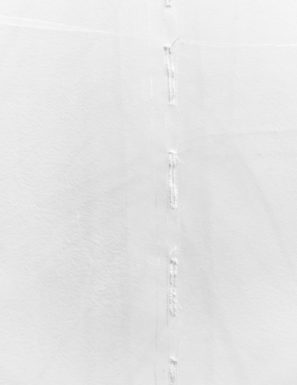
Diana Jean Puglisi, "Too Silver for a Seam" (detail), 2016, Courtesy of the artist.
BJ: What a great observation made by your colleague, it makes an insightful juxtaposition and additional question to this exhibition. For me, art comes in as this communal altar, where we have personal reactions, but we can have them while standing next to someone else feeling something as well. The artist is able to facilitate the convergence of different psychological perspectives, so that for a moment we are brought together, though we do remain individuals. This perhaps brings up more questions about the role of the singular artist… While I do think most things in life tend to be informed by our cultural perspectives, I think that there is always a desire to connect to others, or to be a part of a connection, where we hope that we can communicate with a larger group and that our individuality is respected and even praised.
- Diana Jean Puglisi, “Too Silver for a Seam,” 2016, Courtesy of the artist.
- Diana Jean Puglisi, “Too Silver for a Seam” (detail), 2016, Courtesy of the artist.
- Diana Jean Puglisi, “approach the amber flits,” 2016, Courtesy of the artist
- Diana Jean Puglisi, “approach the amber flits” (detail), 2016, Courtesy of the artist.

